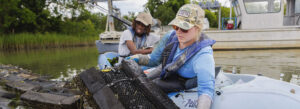No empty stomachs here: VASG researcher studies eels’ dining habits in their historic habitat
The idea to study the relationship between brook trout and American eels first occurred to Jon Studio while he worked on another project in Shenandoah Valley National Park near small mountain streams.
“I happened to notice that in some of the streams with brook trout, there also happened to be American eels in pretty large abundance,” Studio says. “These were up in really, really small headwater streams, so I got to thinking, ‘How is it that brook trout and eels are both living in these streams? Are they possibly competing for food?’”
Studio, a Virginia Sea Grant supported student and recent graduate of James Madison University, wasn’t the only one with this question. He had also heard local anglers grumbling that brook trout have been getting harder to catch, and they blamed this on eels migrating farther inland. Studio found the perfect place to investigate this relationship: Crabtree Creek, a stream divided by a waterfall. There, Studio could compare the brook trout that lived above the falls, where there are no eels, to the brook trout below the falls that coexisted with eels.
There were two potential problems. Eels might be eating the same insects and small fish, leaving less food available for the brook trout, or eels may be eating the young brook trout themselves. Studio examined the stomach contents of both eels and brook trout and tracked the number of fish present over the course of the summer season.
After comparing the brook trout above and below the falls, he found that eels did not eat small brook trout and almost no competition existed between the eels and trout for other food sources.
“All year-round, brook trout and American eels were actively choosing completely different organisms,” Studio explains. “For brook trout, for the most part, they actually ate terrestrial organisms that were falling in, so flies, and things of that nature. They were feeding more at the top of the water column along the surface, whereas eels feed along the bottom. The larger eels were feeding primarily on crayfish.”
Even though the reintroduction of eels to inland streams began within the last few years, brook trout and eels have a long history of coexistence. Before manmade dams blocked eel migration, eels spent the middle portion of their lives far upstream in freshwater with brook trout before making the journey back to the sea to spawn. Even though eels have inhabited these ecosystems before, many aspects of their life, including their impact on other animals, remains unknown.
“There’s very little known about eels, like how long they live in the mountain streams before they go to spawn in the ocean,” says Christine May, an associate professor of biology at James Madison University and Studio’s research advisor. “There’s very little known about what they eat, or how they influence the communities they’re in.”
“How is it that brook trout and eels are both living in these streams? Are they possibly competing for food?”
After comparing the brook trout above and below the falls, he found that eels did not eat small brook trout and almost no competition existed between the eels and trout for other food sources.
Since both brook trout and American eels have generally been declining in recent years, conservation efforts are underway to prop up both species. For brook trout, this includes habitat restoration and stocking of hatchery-raised fish. For eels, these efforts consist of removing dams or installing eel ladders that allow them to migrate over dams. Since the eels and brook trout don’t compete heavily, both these conservation efforts can continue without undermining each other.
Studio’s work helps clear up some of the misunderstandings about the relationship between eels and brook trout. Not only can the two peacefully coexist, their presence can strengthen the entire habitat—a phenomenon known as the multiple predator effect, which occurs when two top predators live in the same ecosystem but use different resources. It’s a beneficial relationship that was hidden by the misconceptions about eels and trout.
“That can be hugely important moving forward because there are some very invasive species of crayfish coming into our area as well as other areas of the world where eels are present,” May explains. “Eels can actually add a lot of resistance because they prey so heavily on crayfish, and they could potentially prevent some of the invasion of these non-native crayfish species.”
Takeaways:
- Dam removal and eel ladders have allowed American eels to migrate farther inland in recent years, causing eel and brook trout populations to overlap in mountain streams.
- Some people thought that competition between the eels and brook trout may be undermining brook trout conservation efforts.
Photos and video by Aileen Devlin | Virginia Sea Grant
Contributed photos and video courtesy of Jon Studio
Story by Madeleine Jepsen | Virginia Sea Grant
Published Sept. 28, 2018.
Not only can the two peacefully coexist, their presence can strengthen the entire habitat—a phenomenon known as the multiple predator effect, which occurs when two top predators live in the same ecosystem but use different resources.





